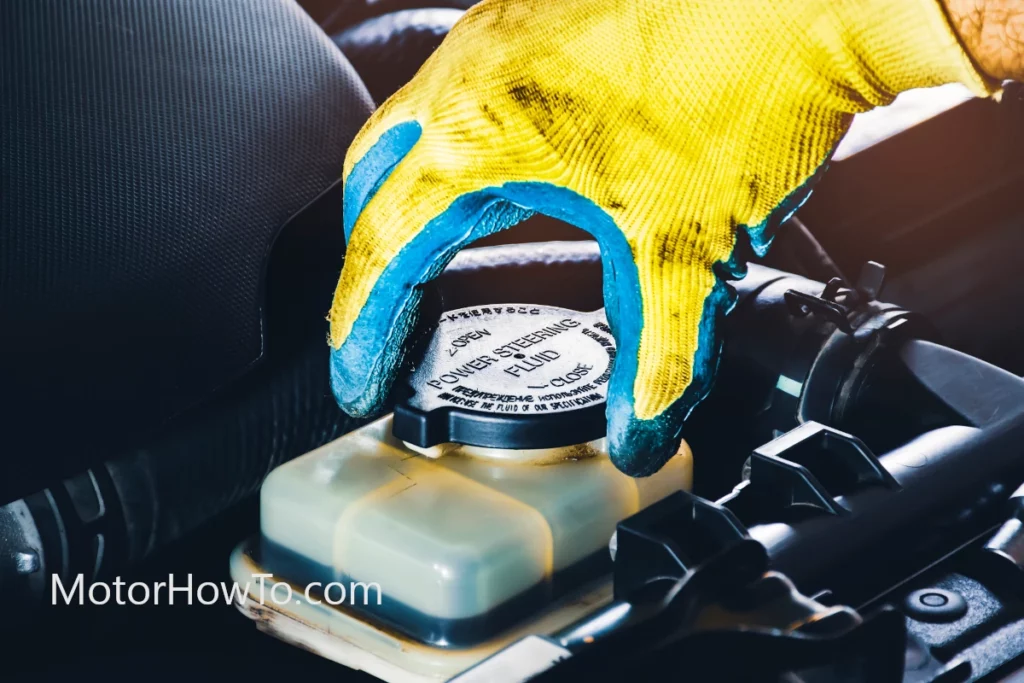Navigating the labyrinth of automotive care can be overwhelming for many, especially when understanding the intricacies of individual components and their associated fluids.
The power steering system is a critical yet often overlooked component in Duramax engines.
Delving into the Duramax power steering fluid world, this article seeks to guide you through its selection, proper maintenance, and the art of troubleshooting.

Equipped with this knowledge, you’ll be better prepared to ensure a smoother ride and prolong the life of your vehicle’s power steering system.
Related:
- Best Lift Pump for Duramax (Upgrading Fuel Efficiency & Performance)
- Best Shocks for 2500HD Duramax (Explained)
- Best Oil for Duramax (Comprehensive Guide)
Understanding the Role of Power Steering Fluid
Power steering fluid serves as the lifeblood of a vehicle’s steering system. This hydraulic fluid transfers force from the steering wheel to the steering gear, enabling drivers to turn the wheels with minimal effort.
As a driver turns the wheel, the fluid acts as a medium to transmit the applied pressure to the steering mechanism, ensuring a responsive and effortless maneuvering experience.
Beyond its primary role, the power steering fluid offers protection. It lubricates the moving parts within the steering system, preventing wear and tear. Moreover, its anti-corrosive properties shield the system’s components from rust and degradation.
Without this fluid, the steering system would be harder to operate, and its components would be at a greater risk of premature wear and potential failure.
Duramax Engines: A Brief Overview
Introduced in 2001, Duramax engines quickly became a standard-bearer in the world of light and medium-duty diesel engines. Developed as a collaboration between General Motors and Isuzu, Duramax was conceived to answer the increasing demand for powerful yet efficient diesel engines in pickup trucks and other large vehicles.
Over the years, these engines have undergone various refinements, but their core commitment to performance, reliability, and fuel efficiency has remained unwavering.
Distinguishing itself from its competitors, the Duramax lineup boasts advanced turbocharging, sophisticated fuel injection systems, and robust construction. These engines are designed to endure heavy loads, tough terrains, and long hauls, all while ensuring optimized fuel combustion and reduced emissions.
Integrating advanced technologies, such as exhaust gas recirculation and selective catalytic reduction, further solidifies Duramax’s reputation for balancing power with environmental responsibility. Whether for work or recreation, Duramax engines have become a top choice among diesel enthusiasts and everyday drivers.
Selecting the Right Fluid: What to Look For
Compatibility with Duramax Engines
The first and foremost consideration when choosing a power steering fluid is its compatibility with Duramax engines. Using an incompatible fluid can lead to a reduced lifespan of the steering components and compromised performance. Manufacturers often specify the type of fluid best suited for their engines. Refer to the vehicle’s owner’s manual or consult a professional to ensure the chosen fluid aligns with Duramax specifications.
Viscosity and Temperature Ratings
Viscosity, in simple terms, is the measure of a fluid’s resistance to flow. The right viscosity ensures smooth steering even under extreme conditions for power steering fluids. It’s essential to pick a fluid that maintains optimal viscosity across a wide temperature range, ensuring consistent performance in the blazing summer heat or the chilling winter cold. Look for temperature ratings on the fluid container, and ensure it matches the most extreme conditions your vehicle might encounter.
Fluid Additives and Their Benefits
Additives in power steering fluid provide various benefits, enhancing its overall functionality. Common additives include:
- Anti-wear agents protect the steering components from wear and tear, prolonging their lifespan.
- Detergents: This help keep the system clean by breaking down and preventing the accumulation of deposits.
- Antioxidants: These prevent the fluid from oxidizing, which can lead to increased viscosity and reduced efficiency.
- Anti-foaming agents: Foam can introduce air into the system, which may lead to erratic steering. These agents keep foaming at bay.
- Corrosion inhibitors: To shield the metallic components from corrosion and rust.
When selecting a fluid, consider the added benefits these additives bring. They not only ensure the longevity of the steering system but also optimize its performance.
Maintenance Best Practices
Consistent performance starts with adequate fluid levels. Periodically checking the power steering reservoir ensures the system has enough fluid to function correctly. Low fluid levels can lead to decreased steering efficiency and potential damage.
A dipstick or sight glass on the reservoir often aids in this task. If the level is consistently low, it might indicate a leak that needs immediate attention.
Over time, power steering fluid can degrade or become contaminated. Some telltale signs include a darkened or burnt smell, visible debris or particles in the fluid, or a noticeable change in the steering’s responsiveness.
If the steering becomes noisy or you hear whining when turning the wheel, it’s often a signal that the fluid is old or contaminated and requires replacement.
While power steering fluid doesn’t need as frequently changing as engine oil, adhering to recommended change intervals is crucial. Typically, every 50,000 to 100,000 miles is a general benchmark, but refer to the vehicle’s owner’s manual for specific guidance.
Regular fluid changes ensure the system remains free from contaminants and operates efficiently.
Power steering fluid is an environmental hazard and should never be discarded carelessly. Collect the used fluid in a sealed container instead of pouring it down drains or into the ground.
Many automotive shops and local waste disposal facilities offer disposal services for automotive fluids. By disposing of it responsibly, you safeguard the environment and adhere to legal standards in many jurisdictions.
Troubleshooting Common Issues
Symptoms of Low Power Steering Fluid
Low-power steering fluid can manifest in several ways:
- Hard Steering: The most noticeable symptom is the steering wheel becoming stiff or hard to turn.
- Noisy Operation: You might hear a whining or squealing noise, especially when making sharp turns.
- Erratic Power Assist: The steering might feel normal at one moment and become stiff the next.
- Vibrations: A pulsing or vibrating sensation can be felt in the steering wheel, particularly when the vehicle is stationary.
Noises and What They Indicate
Distinctive sounds can point toward specific issues:
- Whining or Squealing: Often indicative of low fluid levels or air entering the system.
- Groaning or Creaking: This can suggest old or contaminated fluid or possible component wear.
- Clicking or Knocking: This may indicate mechanical issues in the steering system or damaged components.
Listening to these sounds can provide early warnings, allowing timely interventions.
How Temperature Affects Performance
Temperature plays a pivotal role in how the power steering system operates:
- Cold Temperatures: Fluid can thicken, leading to hard steering, especially upon startup. Having a fluid with a suitable viscosity rating for colder climates is crucial.
- Hot Temperatures: Prolonged exposure to high temperatures can degrade the fluid faster, impacting its effectiveness and potentially causing the steering to feel sloppy or loose.
Responding to Leaks and Seal Issues
Leaks are a common problem in power steering systems, and addressing them promptly is essential:
- Spotting Leaks: Frequent top-ups or visible puddles beneath the vehicle can indicate a leak. Key areas to check include hose connections, seals, and the power steering pump.
- Seal Deterioration: Seals can wear out over time, allowing fluid to escape. If you notice a slow but consistent drop in fluid levels, it’s worth checking the integrity of the system’s seals.
- Addressing Leaks: For minor leaks, there are sealant products available that can provide a temporary fix. However, for major issues or if the problem persists, it’s advisable to consult a professional mechanic for a thorough inspection and repair.
By being observant and addressing these issues promptly, you can prolong the life of your power steering system and ensure a safer driving experience.
The Importance of Using Genuine or Approved Products
Using genuine or manufacturer-approved products in automotive care can significantly influence a vehicle’s performance, longevity, and safety. This choice becomes even more paramount when addressing components like the power steering system.
- Optimal Performance: Genuine or approved products are crafted precisely and tailored for a particular model or engine type. This ensures that the fluid’s properties – viscosity, additive content, or thermal stability – are in sync with what the system was engineered for, leading to peak performance.
- Longevity of Components: Authentic products undergo rigorous testing to protect the vehicle’s parts from premature wear and tear. By maintaining the right lubricity, preventing corrosion, and ensuring consistent flow, genuine fluids can prolong the life of the power steering system and its associated components.
- Safety: Steering plays a crucial role in the safe operation of a vehicle. Compromising on the quality of fluid can lead to unpredictable steering behavior, putting the driver and other road users at risk. Genuine or approved products guarantee consistent performance, even under extreme conditions, ensuring safety remains uncompromised.
- Warranty and Peace of Mind: Using non-approved products can sometimes void a vehicle’s warranty. Manufacturers often stipulate the use of specific products to maintain warranty validity. Beyond the technical and financial implications, there’s also the peace of mind that comes from knowing you’re using a product specifically designed for your vehicle.
- Economic Implications in the Long Run: While genuine products might sometimes come with a higher price tag upfront, the long-term savings in potential repairs, replacements, and enhanced longevity often outweigh the initial cost.
In conclusion, while the market is flooded with many automotive products promising various benefits, it’s prudent to remember the adage – “You get what you pay for.” Investing in genuine or manufacturer-approved power steering fluids ensures your vehicle receives the care it deserves, guaranteeing optimal performance, safety, and longevity.
Conclusion
In conclusion, this article has shed light on the often-overlooked but crucial aspect of Duramax power steering fluid. It underscores the vital role this hydraulic fluid plays in ensuring smooth and responsive steering while protecting the system’s components from wear and corrosion.
The article has provided valuable insights into selecting the right fluid, maintaining it properly, and troubleshooting common issues, all of which are essential for preserving the vehicle’s performance and safety.
Furthermore, the emphasis on using genuine or manufacturer-approved products serves as a reminder that quality and compatibility should never be compromised when it comes to a vehicle’s vital components.
While it may require a bit more investment upfront, the long-term benefits in terms of performance, component longevity, and overall safety make it a wise choice.
By understanding the significance of power steering fluid and following the guidelines outlined in this article, Duramax engine owners can ensure that their vehicles continue to deliver the powerful and reliable performance they are known for, even in the often challenging conditions they are designed to handle.



